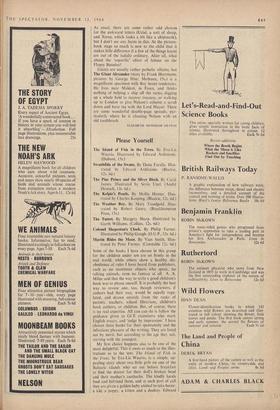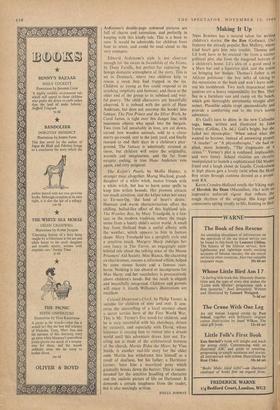Please Yourself
The Island of Fish in the Trees. By Eva-Lis Wuorio. Illustrated by Edward Ardizzone. (Dobson, 15s.) Colonel Sheperton's Clock. By Philip Turner.
trated by Peter Forster. (Constable I 2s. 6d.)
• SOME of the books I have chosen in this group for the children under ten are set firmly in the real world, while others show a healthy dis- obedience of rules I have heard from publishers, such as no inanimate objects who speak, no talking animals, even no fantasy at all. A. A. Milne said that the way to write a good children's book was to please oneself. It is probably the best way to review one, too, though reviewers, if authors had their way, would be equally regu- lated, and drawn entirely from the ranks of parents, teachers, school librarians, children's book authors, or children. But, of course, there is no real expertise. All you can do is follow the guidance given to GCE examiners who mark English essays, and 'judge by impression.' I have chosen these books for their spontaneity and the infectious pleasure of the writing. They are listed not by merit, but according to the age they suit, starting with the youngest.
My first choice happens also to be one of the most delightful. This it owes as much to the illus- trations as to the text. The Island of Fish in the Trees, by Eva-Lis Wuorio, is a simple, ap- pealing story about two little girls on one of the Balearic islands who set out before breakfast to find the doctor for their doll's broken head and their mother's toothache. The kindly locals feed and befriend them, and at each port of call they are given a golden baby animal to take home: a kid, a puppy, a kitten and a donkey. Edward
Ardizzone's double-page coloured pictures are full of charm and animation, and perfectly in keeping with this kindly tale. This is a book to save. It would be admirable for children from four to seven, and could be read aloud to the very youngest.
Edward Ardizzone's style is not clear-cut enough for the swans in Swanhilda of the Swans, by Dana Faralla, but perfect for capturing the benign domestic atmosphere of the story. This is set in Denmark, where two children help to rescue a swan they find trapped in the ice. Children as young as five could respond to its touching simplicity and humour, and those at the older end of the group to its subdued and wist- ful poetry. The child characters are beautifully observed. It is imbued with the spirit of Hans Andersen, but does not overstep the border into fantasy. The Pine Prince and the Silver Birch, by Carol James, is right over this danger line, with inanimate objects who speak into the bargain. Two trees fall unsuitably in love, are cut down, carved into wooden animals, sold to a circus merry-go-round, sent to the junk yard, and finally rescued to end their days in a children's play- ground. The fantasy is admittedly strained at times, but children will enjoy the originality, warmth and imagination, and the far from escapist ending, in true Hans Andersen vein again, and very poignant.
The Kelpie's Pearls, by Mollie Hunter, is stronger meat altogether. Morag Macleod, grand- daughter of a white witch, makes friends with a white witch, but has to learn some spells to keep him within bounds. Her prowess attracts too much attention, and the kelpie takes her away to Tir-nan-Og, 'the land of heart's desire.' Humour and warm characterisation offset the - chilling, ballad-like effect of this highland tale. The Weather Boy, by Mary Treadgold, is a fan- tasy, in the modern tradition, where the magic stems from a lonely child's secret world. A small boy from Holland finds a useful affinity with the weather, which appears to him in human shape. Mary Treadgold has a sprightly style and a sensitive: touch. Margery Sharp indulges her own fancy in The Turret, an engagingly unin- hibited tale about the talking mice of the Mouse Prisoners' Aid Society. Miss Bianca, the charming ex-chairwoman, rescues a reformed villain, helped by some mouse Scouts and a famous race- horse. Nothing is too absurd or incongruous for Miss Sharp, and her vocabulary is provocatively above children's heads. But the result is elegant and beautifully integrated. Children and parents will enjoy it. Garth Williams's illustrations are excellent.
Colonel Sheperton's Clock, by Philip Turner, is suitable for children of nine and over. It con- cerns the unravelling of a local mystery about a secret service hero of the First World War. This is Mr. Turner's first novel for children, and he is very successful with his choirboys, driven by curiosity, and especially with David, whose lameness is causing him to retreat into a dream world until this adventure draws him out. Ex- citing use is Made of the architectural features of the church. Martin Rides the Moor, by Vian Smith, is another real-life story for the older ones. Martin has withdrawn into himself as a result of deafness, but his father, a Dartmoor farmer, buys him a moorland pony which gradually breaks down the barrier. This is recom- mended' for the sensitive handling of character and the realistic picture of life on Dartmoor. It demands a certain toughness from the reader, but is also movingly written.
STELLA RODWAY











































 Previous page
Previous page